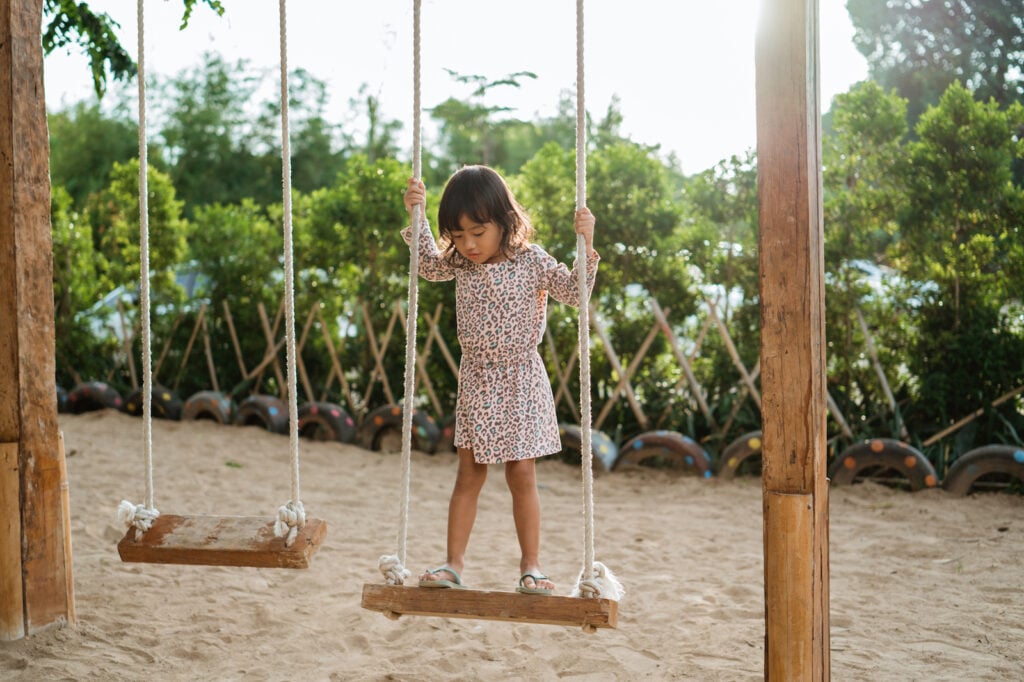Nervous System Regulation for Kids: Help Your Child Feel Safe & Calm
Our kids live in an overstimulating world. From screens and busy schedules to minor or major traumas, their nervous systems are often on high alert. If it feels like your child gets dysregulated easily, these nervous system regulation tools can really help.
With insight from brain science, this guide shares simple and effective ways to help your child feel safe in their body, reset after overwhelm, and build long-term emotional resilience.

Most of us didn’t need a toolbox of regulation activities when we were kids. We grew up in a calmer, less stimulating world. Life was just simpler when we were kids.
Mother Nature was our somatic healer. We played outside until dinnertime, so our circadian rhythm was balanced. And as tweens or teens, we had our share of friend drama, but it was lower stakes compared to what young people face today with social media.
Why Nervous System Regulation Is Essential for Kids
We have all experienced it. Out of nowhere, our child loses their cool over what seems to us to be a small thing. Perhaps it’s a meltdown while you are out grocery shopping, or an uncharacteristic, “Oh shoot, is that MY kid who just did that?” behavior at the playground.
As parents, we can be flooded with reactions ourselves, feel internal or external judgment, or we can even begin to panic wondering, “How do I make this stop right now?”
But what if we paused and saw these behaviors for what they truly are: a message from the body saying, “I don’t feel safe right now.”
By understanding the critical role of the nervous system in these situations, we can have a leg up as parents and work proactively to support ourselves and our kids as these inevitable moments arise.
Cutting edge research and discoveries in landmark books like The Body Keeps the Score by Bessel van der Kolk and Anchored by Deb Dana and Stephen Porges, a pioneer in the polyvagal theory, have collectively deepened our understanding that these “challenging behaviors” come down to one common thread – a lack of safety.
When a child feels safe and supported, their body and brain can return to balance. When they don’t, behaviors like hitting, yelling, defiance, or withdrawal can take over.
What Happens in a Child’s Body During Stress
Based on the latest findings in neuroscience, we know that at the root of hitting, yelling, talking back, meltdowns, trouble falling asleep and more, indicate that the body is in a state of stress. To better understand how to support your child, it helps to know what’s happening in their body.
The autonomic nervous system has two main branches:
- Sympathetic nervous system (“S” for stress): Activates fight, flight, or freeze when a child feels unsafe (real or perceived).
- Parasympathetic nervous system (“P” for peace): Helps the body return to a calm, regulated state.
In a properly functioning system it would turn on when there is a real threat or danger and then regulate back to homeostasis. But in our “always on” culture, many kids stay stuck in stress mode.
Signs of nervous system dysregulation in children include:
- Frequent meltdowns or tantrums
- Trouble falling or staying asleep
- Sensitivity to noise, texture, or transitions
- Aggressive behavior or emotional shutdown
- Difficulty focusing or sitting still
It is not surprising in our high tech, high activity, “always on” society, that kids’ nervous systems are being triggered frequently, and many times they do not have the support or tools to regulate their bodies.
How to Help a Child Regulate Their Nervous System
One of the most powerful ways to help your child regulate is by regulating yourself first. When you stay calm and grounded, your child can borrow that safety through a process called co-regulation.
Below are two kinds of practices that support regulation:
In-the-Moment Support: When Emotions Are High
When your child is already dysregulated, these “triage” practices help bring them back to calm:
Model regulation yourself
Take a deep breath. Feel your feet on the floor. Say a simple mantra like “Peace begins with me.” Let your child see you place a hand on your heart and breathe slowly — a visual cue that often helps them mirror your calm.
Try these regulation tools together
- Deep Breathing
Try a box breath or belly breath. Breathing into the lower back ribs is especially helpful. You can also use a guided breathing meditation for kids. - Alternate Nostril Breathing
This yoga and meditation technique helps calm the mind, balance the energy, and bring harmony to the nervous system. This practice is believed to bring balance to the right and left hemispheres of the brain, leading to a feeling of relaxation and stress relief. Here’s how to do it:- Use the thumb and ring finger of one hand to gently block your right nostril. Inhale deeply through your left nostril.
- Close your left nostril with your right thumb and release your right nostril. Exhale through the right nostril.
- Inhale through the right nostril and then close it with your right ring finger. Open your left nostril and exhale through the left.
- Repeat this pattern for several rounds, taking deep, slow breaths and focusing on your breath.
- Shaking
Start by shaking your hands or feet. If that feels good, add other parts of the body. The goal is to reduce those feelings of tightness, tension, or jangled nerves. Don’t shake hard enough to injure yourself. - Singing or Humming
This stimulates the vagus nerve and helps connect us to our emotions. Allow yourself to feel any emotions that come up (laugh, cry, get angry). Feel free to make other sounds if they’re helpful. - Hugging
Hugging is a co-regulation technique where one person receives nervous system regulation from an already regulated person. If you are calm, hug your child until they feel their body relax (around 20 seconds). The oxytocin flood can bring on feelings of joy and improve the immune system. - Butterfly Hug
Teach your child this simple tapping technique: Cross their arms over their chest like a self-hug and gently tap their shoulders while taking deep breaths. It’s one of the best somatic exercises for kids. - Grounding (Earthing)
Go barefoot on the grass, lie on the ground, or hug a tree. Teaching kids how to ground in nature is one of the fastest ways to calm a dysregulated body.
Foundational Practice: Build Daily Nervous System Resilience
While you can embed soothing practices and moments into any time of your day, one of the most effective windows to support the regulation of the nervous system is right before bedtime.
We can pick up all types of things that disrupt our nervous systems or make us feel unsafe throughout the day. By setting an intention and regularly practicing deep breathing before sleep, we can release tension and reset our nervous systems to come back into homeostasis.
To practice with your kids, you can invite them to lay down on their bed and close their eyes. Try a body scan meditation where you ask them to take a deep breath and release any tightness or tension from their bodies starting from the toes all the way up to their head.
You can then invite them to share or release any experiences or thoughts from their day that they’d like to let go of. You can then close the practice with your own mantra or saying that is meaningful for your family (e.g., a prayer, a message of love, etc.).
More Tools to Support Your Child’s Nervous System
Want more mindfulness and calming tools to help your child feel grounded and safe?
Explore our:
60+ Guided Meditation Scripts for Kids
Outdoor Mindfulness Art Activities
Emotion Regulation Guided Meditation
Somatic Exercises for Kids
Top 8 Guided Meditations for Sleep
How Time Spent Outdoors Improves Sleep
Mindfulness Exercises for Tweens & Teens

